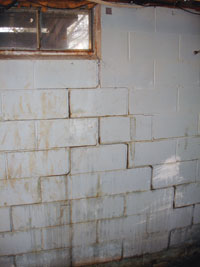 Ask the Expert: Basements
Ask the Expert: Basements
A basement can be a great place for entertaining and expanding your living space. Basements can be fully underground or a walkout type. When I am showing a client a home with a basement one of the first things I pay attention to while walking down the stairs is the smell. Do I smell a strong mildew smell? Does the air feel damp? These are some of the first signs there is a problem with the home. What are some of the other signs? I decided to ask a local expert on the subject and he offered us 7 things to look for when purchasing a basement home. – Tamela
What are 7 things to look for when purchasing a basement home?
by Ren Ramsey
Your visual should begin before you enter the home:
- Does the house have gutters? Are the gutters clean or can you see leaves or even weeds growing out of the gutters? Are the downspouts functional and piped away from the foundation? Gutters and downspouts are there to channel the roof drainage away from the foundations. Roof drainage allowed to be drained at the foundation wall find its way into the basement.
 Look for a white powdery substance on the masonry walls. In a completely finished basement you may have to find a utility room that is not finished that is against the foundation wall holding back soil fills around the basement. This white powdery substance is called efflorescence. It is a sign of moisture entering the basement. It is the salts and minerals in the masonry that are brought to the surface by the moisture as it moves through the wall and is left deposited when the moisture evaporates.
Look for a white powdery substance on the masonry walls. In a completely finished basement you may have to find a utility room that is not finished that is against the foundation wall holding back soil fills around the basement. This white powdery substance is called efflorescence. It is a sign of moisture entering the basement. It is the salts and minerals in the masonry that are brought to the surface by the moisture as it moves through the wall and is left deposited when the moisture evaporates.- Mildew or mold smell. If you can smell it then you have mold somewhere. Mildew is just another term for mold. Mold requires moisture, oxygen and temperatures that we live in to survive. The only thing that we can control is to keep the moisture from entering the basement. Starting to see a trend here? So the first thing that should be done to treat the mold is to fix the moisture problem.
- If you can see the bare block or concrete walls, are there cracks and what type are they? Horizontal cracks indicate bowing of the wall inward. This means that the wall is in failure and is responding to pressure from the soils on the other side. That pressure is typically cause by the hydrostatic pressure of expansive soils cause by excessive, you guessed it, MOISTURE. This could, be because the gutters are not performing properly or the downspouts have not been piped away from the foundation. It does little good for the gutters to function perfectly only to have the downspout dump the roof drainage directly at the foundation.
 Cracks in the brick veneer, this again can be caused by improperly piped away downspouts. Roof drainage dumped right at the corner will cause the soils to expand due to moisture content. When the moisture evaporates, the weight of the structure pushes them down and literally compacts them causing cracks in the brick veneer and foundation. They are usually stair stepped cracks in the corners but can occur in the center of the wall.
Cracks in the brick veneer, this again can be caused by improperly piped away downspouts. Roof drainage dumped right at the corner will cause the soils to expand due to moisture content. When the moisture evaporates, the weight of the structure pushes them down and literally compacts them causing cracks in the brick veneer and foundation. They are usually stair stepped cracks in the corners but can occur in the center of the wall.- Basements that have been finished after the original construction. Typically the homeowner may have been a weekend Home Depot warrior or had a 3rd cousin once removed who knew all about electrical and could wire that new man cave up in an afternoon. Beware. Electrical deficiencies are a life safety issue and a leading cause of fires. If the construction looks less professional than the rest of the house and cheaper materials were used, it probably was performed by the homeowner.
- Lastly, testing for Radon should be performed in basement homes. The EPA recommends that all homes be tested for Radon, particularly in basement homes. Radon will come in through the cracks in the slab and walls that you can’t see due to finished surfaces. Radon is the second leading cause of lung cancer next to smoking and the second leading cause of death next to drunk driving. Radon exposure causes 12,000-30,000 deaths each year. More on Radon in a future “ Ask the expert”
We have only scratched the surface on what to look for in a basement home. Most of the things that you look for in a basement home should also be looked for in a crawlspace home. The best advice is to hire a competent home inspector who has been around for a while. They know what to look for and it is second nature to them. A good inspector sees problems immediately and knows how big of an issue they are or are not. Choose an inspector who inviters you along for the whole inspection and then will sit down with you and explain every item until you are confident you have a good grasp of what he or she has found.
The fee for an inspection is money well spent to help you know if what you are buying is going to be a money pit or truly a comfortable home for years to come. Otherwise, as the saying goes,” You’re buying a pig in a poke!”
Most homes are inspected as part of a real estate transaction. Unless you plan to never sell your home, in all probability, you will have to deal with an inspection. Better to deal with it when you can dictate the outcome than later.
If you ever have any questions about anything home related drop us a note or gives us a call. We love teaching people about their homes.
JW Ramsey & Son Home Inspections
Ren Ramsey, President
www.gastoniahomeinspection.com
ramdino@shelby.net
704-460-4634






